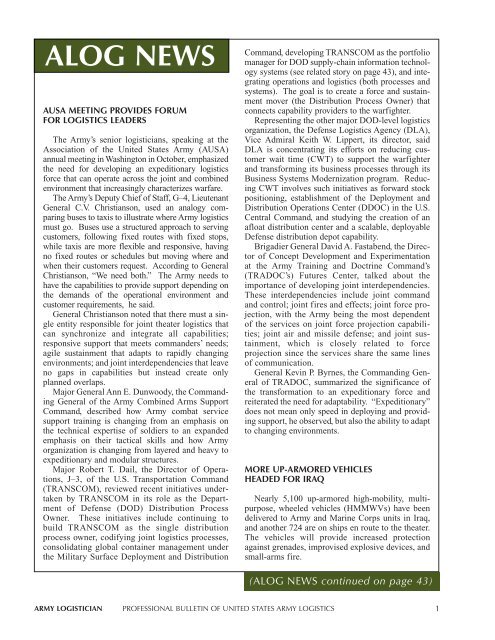Supporting the First Stryker Brigade in Iraq - Army Logistics ...
Supporting the First Stryker Brigade in Iraq - Army Logistics ...
Supporting the First Stryker Brigade in Iraq - Army Logistics ...
Create successful ePaper yourself
Turn your PDF publications into a flip-book with our unique Google optimized e-Paper software.
ALOG NEWS<br />
AUSA MEETING PROVIDES FORUM<br />
FOR LOGISTICS LEADERS<br />
The <strong>Army</strong>’s senior logisticians, speak<strong>in</strong>g at <strong>the</strong><br />
Association of <strong>the</strong> United States <strong>Army</strong> (AUSA)<br />
annual meet<strong>in</strong>g <strong>in</strong> Wash<strong>in</strong>gton <strong>in</strong> October, emphasized<br />
<strong>the</strong> need for develop<strong>in</strong>g an expeditionary logistics<br />
force that can operate across <strong>the</strong> jo<strong>in</strong>t and comb<strong>in</strong>ed<br />
environment that <strong>in</strong>creas<strong>in</strong>gly characterizes warfare.<br />
The <strong>Army</strong>’s Deputy Chief of Staff, G–4, Lieutenant<br />
General C.V. Christianson, used an analogy compar<strong>in</strong>g<br />
buses to taxis to illustrate where <strong>Army</strong> logistics<br />
must go. Buses use a structured approach to serv<strong>in</strong>g<br />
customers, follow<strong>in</strong>g fixed routes with fixed stops,<br />
while taxis are more flexible and responsive, hav<strong>in</strong>g<br />
no fixed routes or schedules but mov<strong>in</strong>g where and<br />
when <strong>the</strong>ir customers request. Accord<strong>in</strong>g to General<br />
Christianson, “We need both.” The <strong>Army</strong> needs to<br />
have <strong>the</strong> capabilities to provide support depend<strong>in</strong>g on<br />
<strong>the</strong> demands of <strong>the</strong> operational environment and<br />
customer requirements, he said.<br />
General Christianson noted that <strong>the</strong>re must a s<strong>in</strong>gle<br />
entity responsible for jo<strong>in</strong>t <strong>the</strong>ater logistics that<br />
can synchronize and <strong>in</strong>tegrate all capabilities;<br />
responsive support that meets commanders’ needs;<br />
agile susta<strong>in</strong>ment that adapts to rapidly chang<strong>in</strong>g<br />
environments; and jo<strong>in</strong>t <strong>in</strong>terdependencies that leave<br />
no gaps <strong>in</strong> capabilities but <strong>in</strong>stead create only<br />
planned overlaps.<br />
Major General Ann E. Dunwoody, <strong>the</strong> Command<strong>in</strong>g<br />
General of <strong>the</strong> <strong>Army</strong> Comb<strong>in</strong>ed Arms Support<br />
Command, described how <strong>Army</strong> combat service<br />
support tra<strong>in</strong><strong>in</strong>g is chang<strong>in</strong>g from an emphasis on<br />
<strong>the</strong> technical expertise of soldiers to an expanded<br />
emphasis on <strong>the</strong>ir tactical skills and how <strong>Army</strong><br />
organization is chang<strong>in</strong>g from layered and heavy to<br />
expeditionary and modular structures.<br />
Major Robert T. Dail, <strong>the</strong> Director of Operations,<br />
J–3, of <strong>the</strong> U.S. Transportation Command<br />
(TRANSCOM), reviewed recent <strong>in</strong>itiatives undertaken<br />
by TRANSCOM <strong>in</strong> its role as <strong>the</strong> Department<br />
of Defense (DOD) Distribution Process<br />
Owner. These <strong>in</strong>itiatives <strong>in</strong>clude cont<strong>in</strong>u<strong>in</strong>g to<br />
build TRANSCOM as <strong>the</strong> s<strong>in</strong>gle distribution<br />
process owner, codify<strong>in</strong>g jo<strong>in</strong>t logistics processes,<br />
consolidat<strong>in</strong>g global conta<strong>in</strong>er management under<br />
<strong>the</strong> Military Surface Deployment and Distribution<br />
Command, develop<strong>in</strong>g TRANSCOM as <strong>the</strong> portfolio<br />
manager for DOD supply-cha<strong>in</strong> <strong>in</strong>formation technology<br />
systems (see related story on page 43), and <strong>in</strong>tegrat<strong>in</strong>g<br />
operations and logistics (both processes and<br />
systems). The goal is to create a force and susta<strong>in</strong>ment<br />
mover (<strong>the</strong> Distribution Process Owner) that<br />
connects capability providers to <strong>the</strong> warfighter.<br />
Represent<strong>in</strong>g <strong>the</strong> o<strong>the</strong>r major DOD-level logistics<br />
organization, <strong>the</strong> Defense <strong>Logistics</strong> Agency (DLA),<br />
Vice Admiral Keith W. Lippert, its director, said<br />
DLA is concentrat<strong>in</strong>g its efforts on reduc<strong>in</strong>g customer<br />
wait time (CWT) to support <strong>the</strong> warfighter<br />
and transform<strong>in</strong>g its bus<strong>in</strong>ess processes through its<br />
Bus<strong>in</strong>ess Systems Modernization program. Reduc<strong>in</strong>g<br />
CWT <strong>in</strong>volves such <strong>in</strong>itiatives as forward stock<br />
position<strong>in</strong>g, establishment of <strong>the</strong> Deployment and<br />
Distribution Operations Center (DDOC) <strong>in</strong> <strong>the</strong> U.S.<br />
Central Command, and study<strong>in</strong>g <strong>the</strong> creation of an<br />
afloat distribution center and a scalable, deployable<br />
Defense distribution depot capability.<br />
Brigadier General David A. Fastabend, <strong>the</strong> Director<br />
of Concept Development and Experimentation<br />
at <strong>the</strong> <strong>Army</strong> Tra<strong>in</strong><strong>in</strong>g and Doctr<strong>in</strong>e Command’s<br />
(TRADOC’s) Futures Center, talked about <strong>the</strong><br />
importance of develop<strong>in</strong>g jo<strong>in</strong>t <strong>in</strong>terdependencies.<br />
These <strong>in</strong>terdependencies <strong>in</strong>clude jo<strong>in</strong>t command<br />
and control; jo<strong>in</strong>t fires and effects; jo<strong>in</strong>t force projection,<br />
with <strong>the</strong> <strong>Army</strong> be<strong>in</strong>g <strong>the</strong> most dependent<br />
of <strong>the</strong> services on jo<strong>in</strong>t force projection capabilities;<br />
jo<strong>in</strong>t air and missile defense; and jo<strong>in</strong>t susta<strong>in</strong>ment,<br />
which is closely related to force<br />
projection s<strong>in</strong>ce <strong>the</strong> services share <strong>the</strong> same l<strong>in</strong>es<br />
of communication.<br />
General Kev<strong>in</strong> P. Byrnes, <strong>the</strong> Command<strong>in</strong>g General<br />
of TRADOC, summarized <strong>the</strong> significance of<br />
<strong>the</strong> transformation to an expeditionary force and<br />
reiterated <strong>the</strong> need for adaptability. “Expeditionary”<br />
does not mean only speed <strong>in</strong> deploy<strong>in</strong>g and provid<strong>in</strong>g<br />
support, he observed, but also <strong>the</strong> ability to adapt<br />
to chang<strong>in</strong>g environments.<br />
MORE UP-ARMORED VEHICLES<br />
HEADED FOR IRAQ<br />
Nearly 5,100 up-armored high-mobility, multipurpose,<br />
wheeled vehicles (HMMWVs) have been<br />
delivered to <strong>Army</strong> and Mar<strong>in</strong>e Corps units <strong>in</strong> <strong>Iraq</strong>,<br />
and ano<strong>the</strong>r 724 are on ships en route to <strong>the</strong> <strong>the</strong>ater.<br />
The vehicles will provide <strong>in</strong>creased protection<br />
aga<strong>in</strong>st grenades, improvised explosive devices, and<br />
small-arms fire.<br />
(ALOG NEWS cont<strong>in</strong>ued on page 43)<br />
ARMY LOGISTICIAN PROFESSIONAL BULLETIN OF UNITED STATES ARMY LOGISTICS 1







